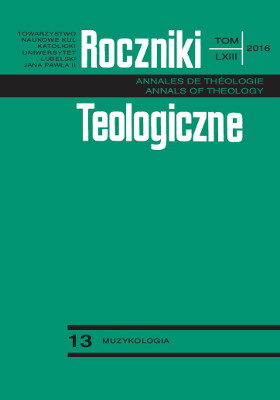Sztuka „akompaniamentu” organowego we Francji na przełomie XVII i XVIII wieku. Jacques Boyvin i jego Traité abregé de l’accompagnement pour l’orgue et pour le clavessin (1705)
The Art of Organ Accompanying in France in the Late 17th Century and in the Beginning of 18th Century. Jacques Boyvin and His Traité abregé de l’accompagnement pour l’orgue et pour le clavessin (1705)
Author(s): Miłosz AleksandrowiczSubject(s): Fine Arts / Performing Arts, Music
Published by: Towarzystwo Naukowe KUL & Katolicki Uniwersytet Lubelski Jana Pawła II
Keywords: art of organ accompanying; France; 17th and 18th century; Jacques Boyvin
Summary/Abstract: The article focuses on the rules of organ playing presented by Jacques Boyvin in his Traité abregé de l’accompagnement pour l’orgue et pour le clavessin (Paris, 1705). Boyvin, born about 1653 in Paris, and died 1706, June 30th, spent most of his life in Rouen, the capital of Normandy. There, since 1676, he occupied the position of cathedral organist, earning fame of one of the most accomplished organists of the second half of the 17th century. His main musical output consists of two collections of organ music: Premier livre d’orgue contenant les huit tons à l’usage ordinaire de l’Eglise, published in Paris in 1690, and Second livre d’orgue contenant les huit tons à l’usage ordinaire de l’Eglise (Paris, 1700) and the above-mentioned treatise, which is considered to be one of the most important sources regarding keyboard playing practice at the turn of 18th century. In the first chapter Traité abrégé Boyvin discusses the main rules of music composition and he explains the symbols used in the transcription of basse continuë. In the second chapter he concentrates on various aspects of practical harmony of sounds. The third chapter includes a list of remarks on practical and performing aspects, which should be followed while playing the organ and the harpsichord. The last chapter (Des transpositions) deals with the important issue of scales transposition, which is often applicable in liturgical music. The important part of this article is the first in Polish literature of the subject, translation of the whole treatise, and the collection of organ exercises (preludes) originally published at the end of the treatise. The author of the article hopes to provide satisfactory amount of information both for organists and musicologists interested in the 18th century French music theory.
Journal: Roczniki Teologiczne
- Issue Year: 63/2016
- Issue No: 13
- Page Range: 5-39
- Page Count: 35
- Language: Polish

